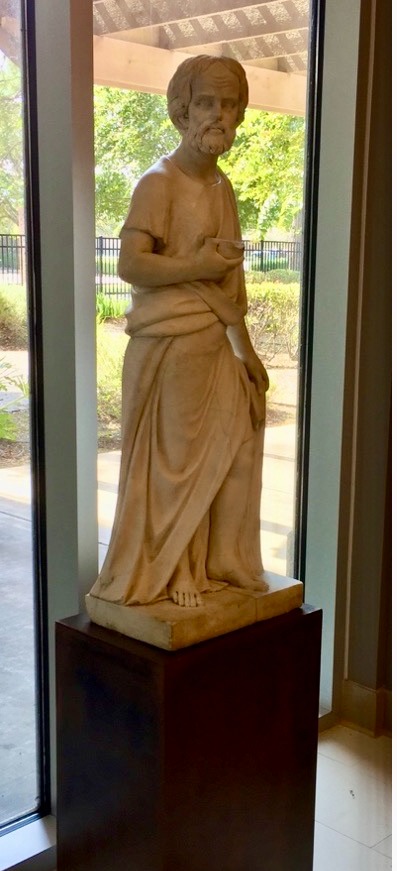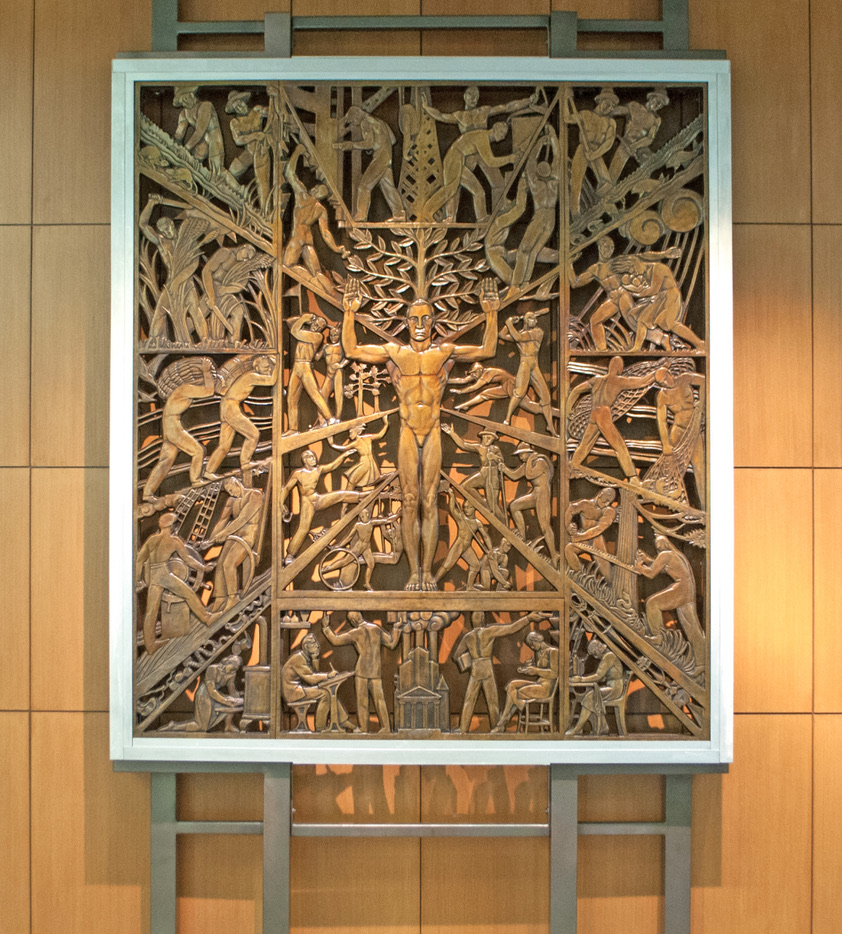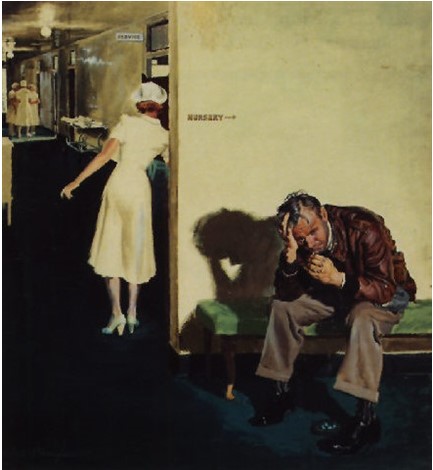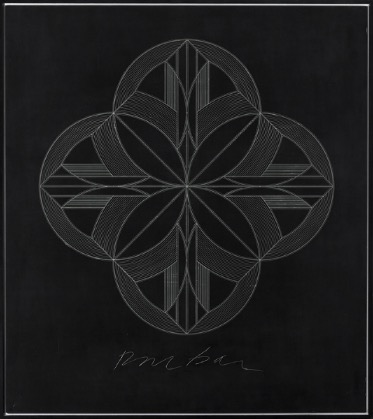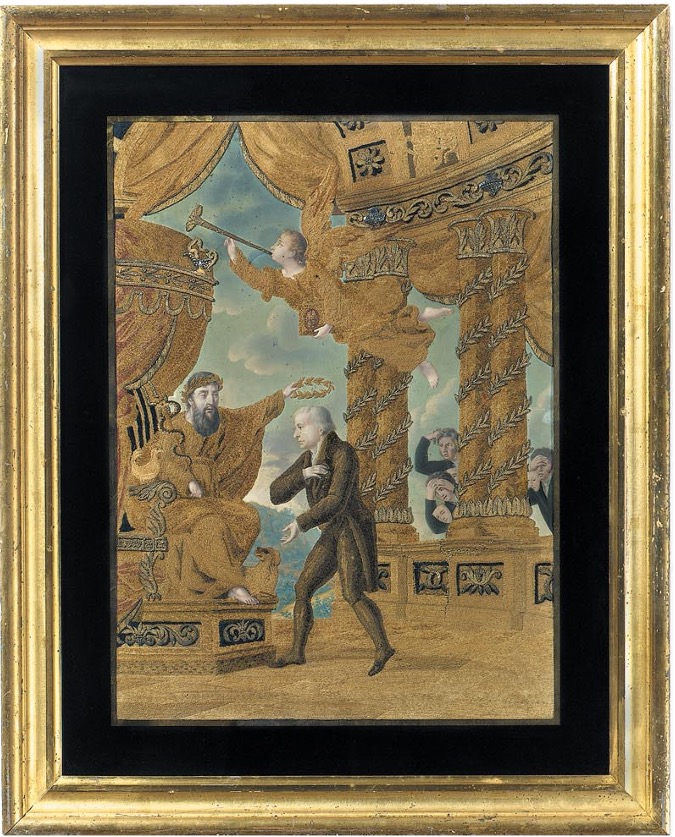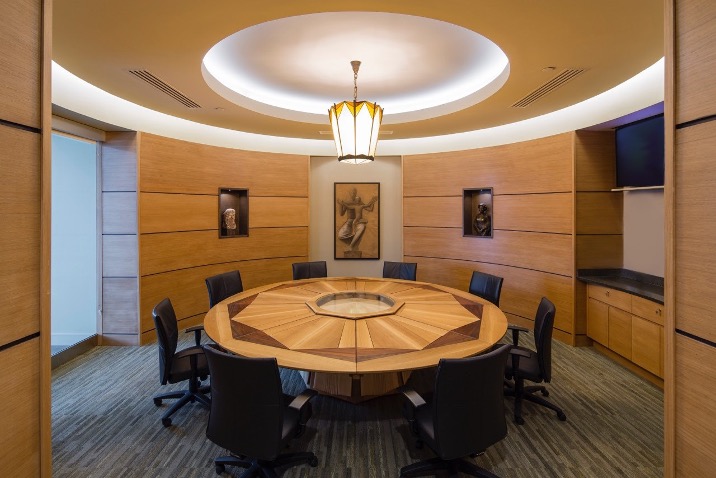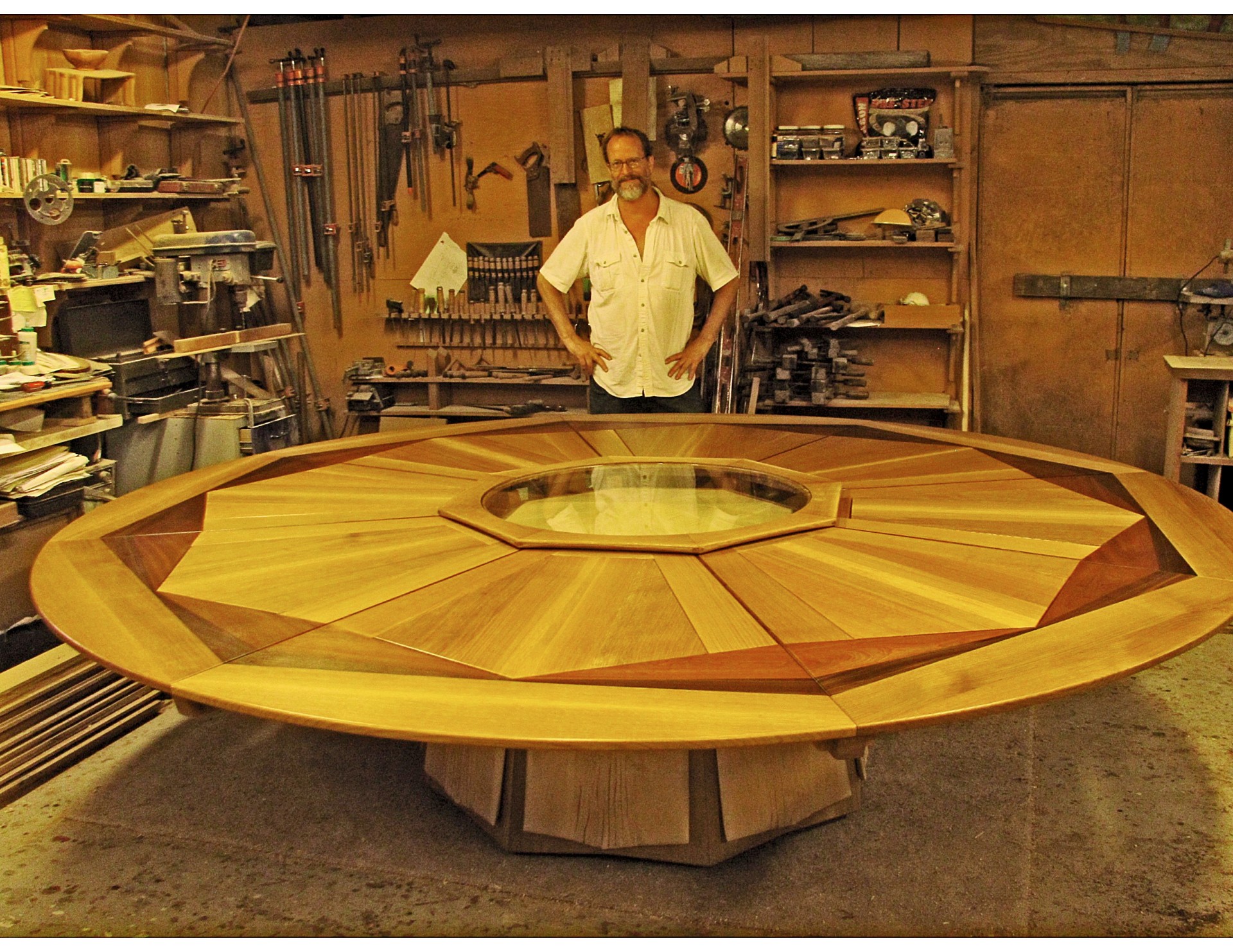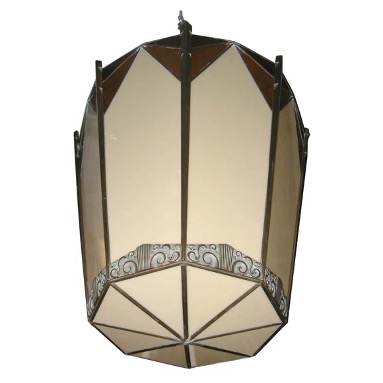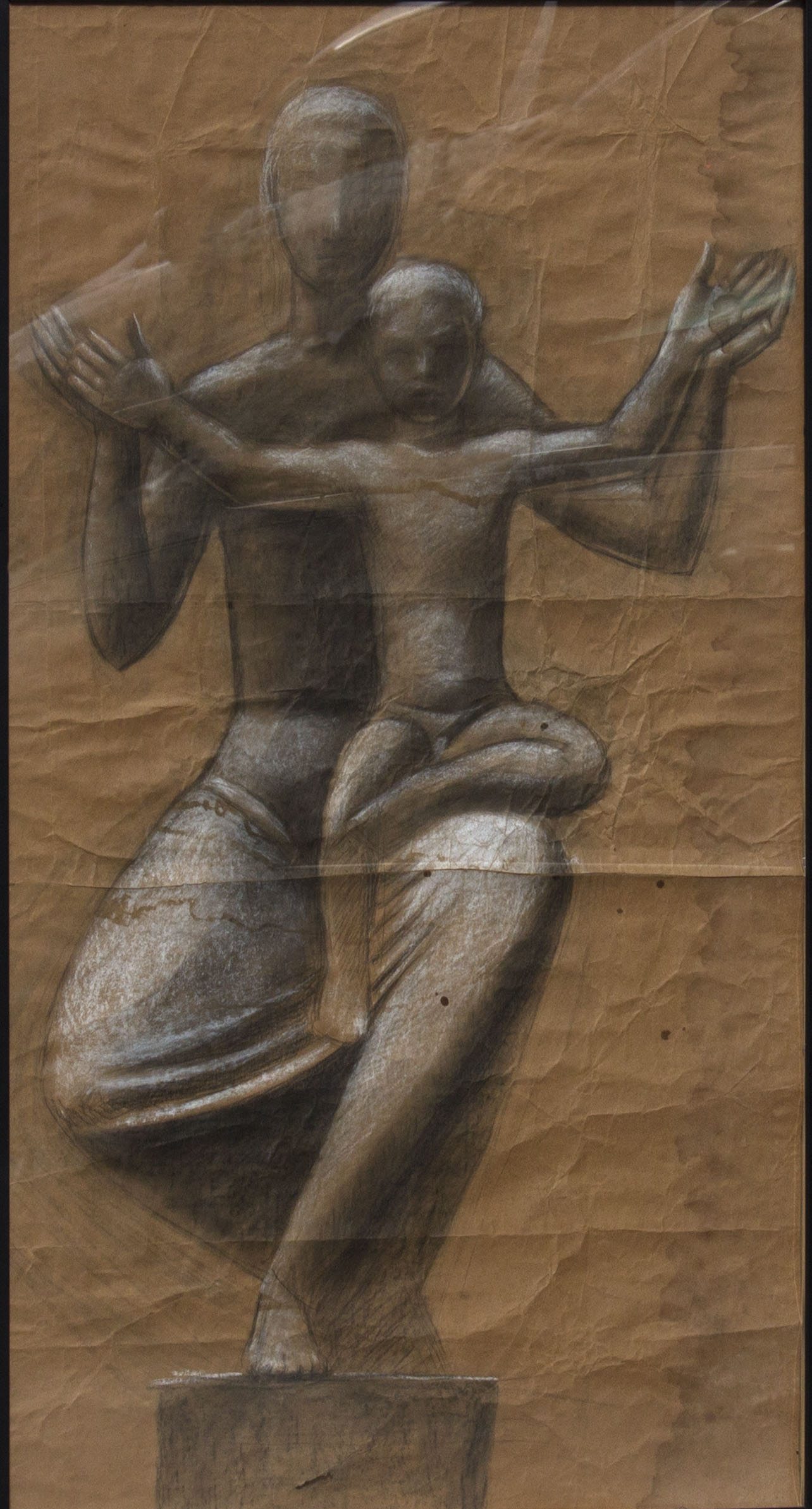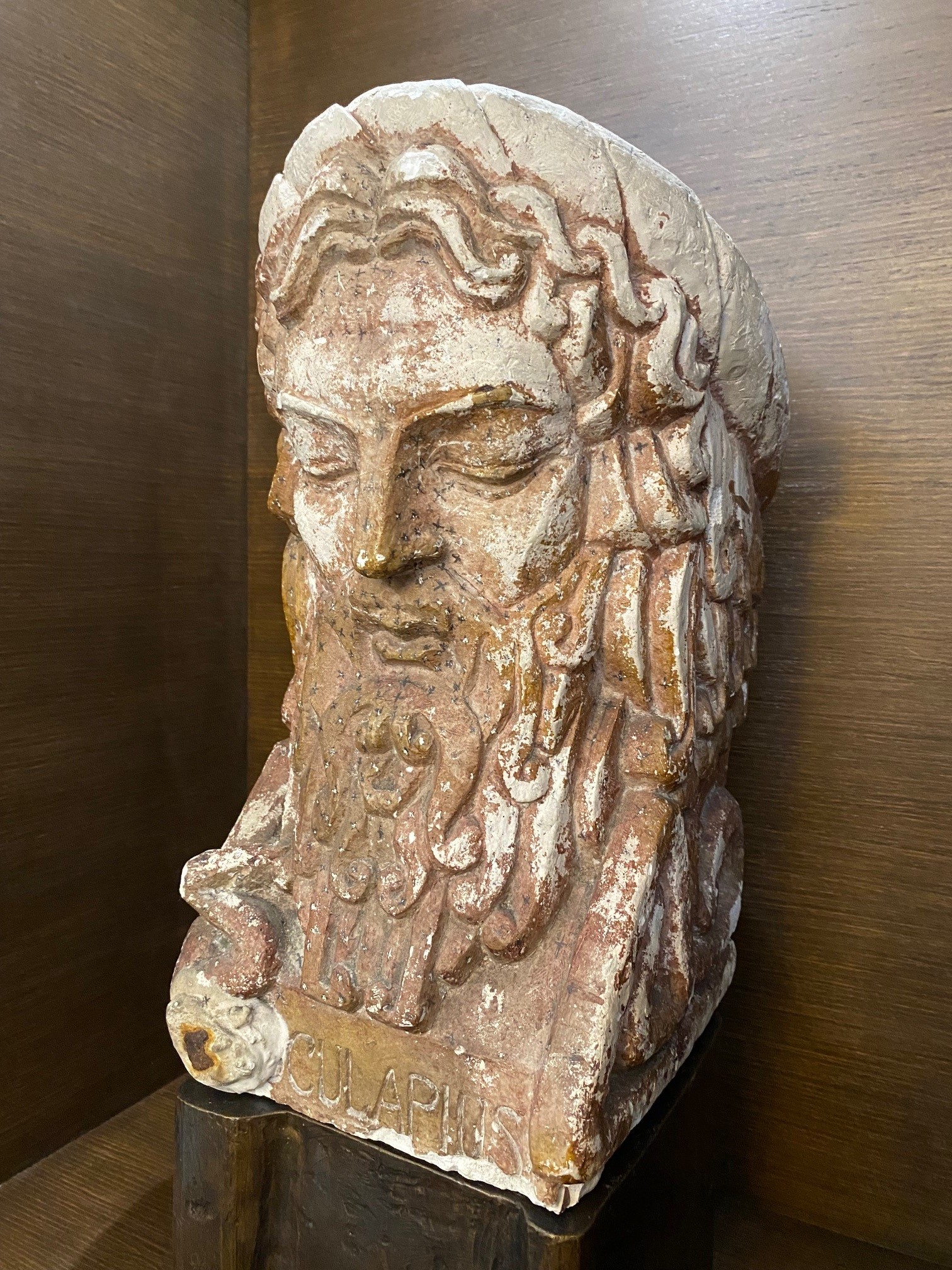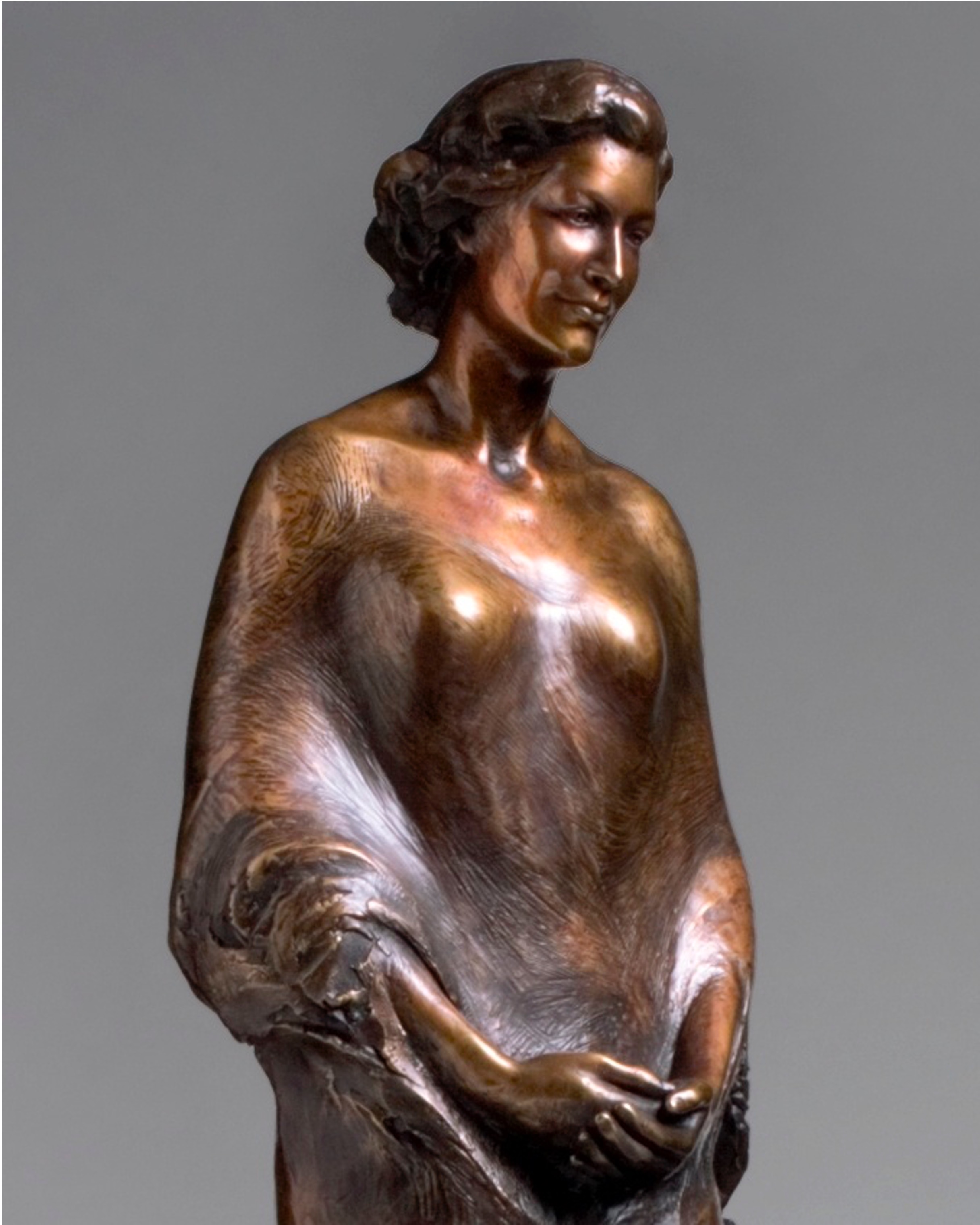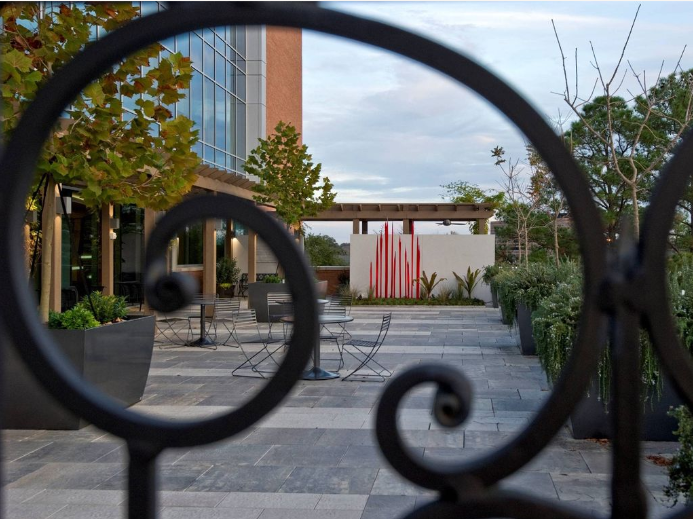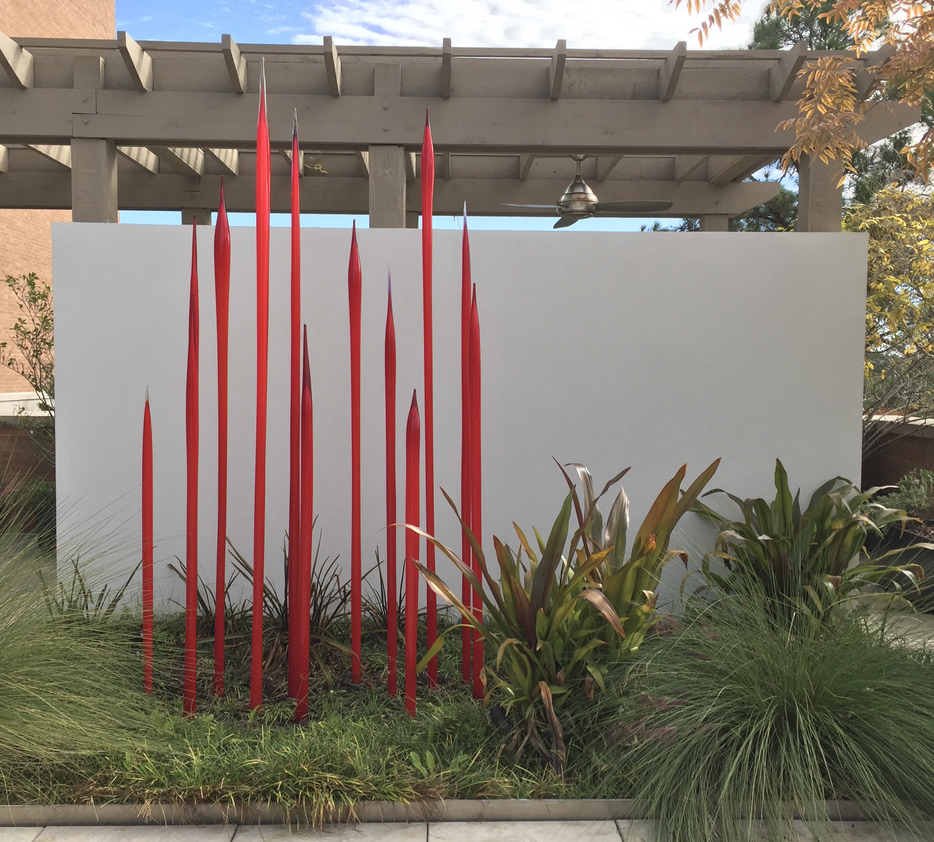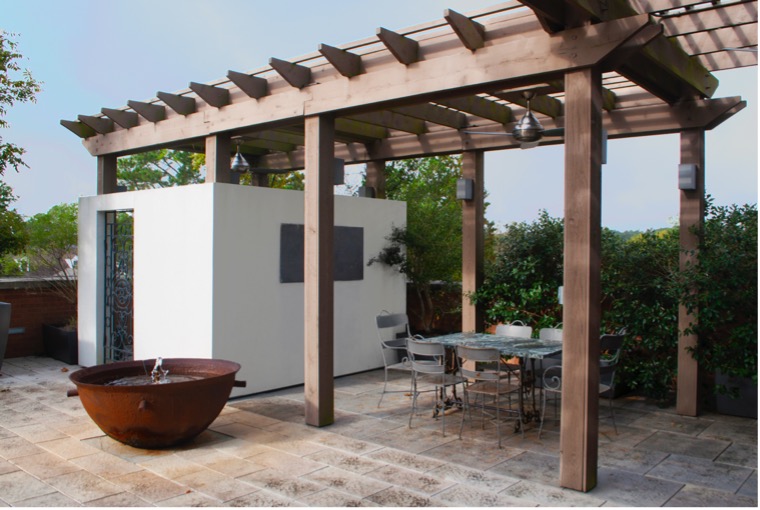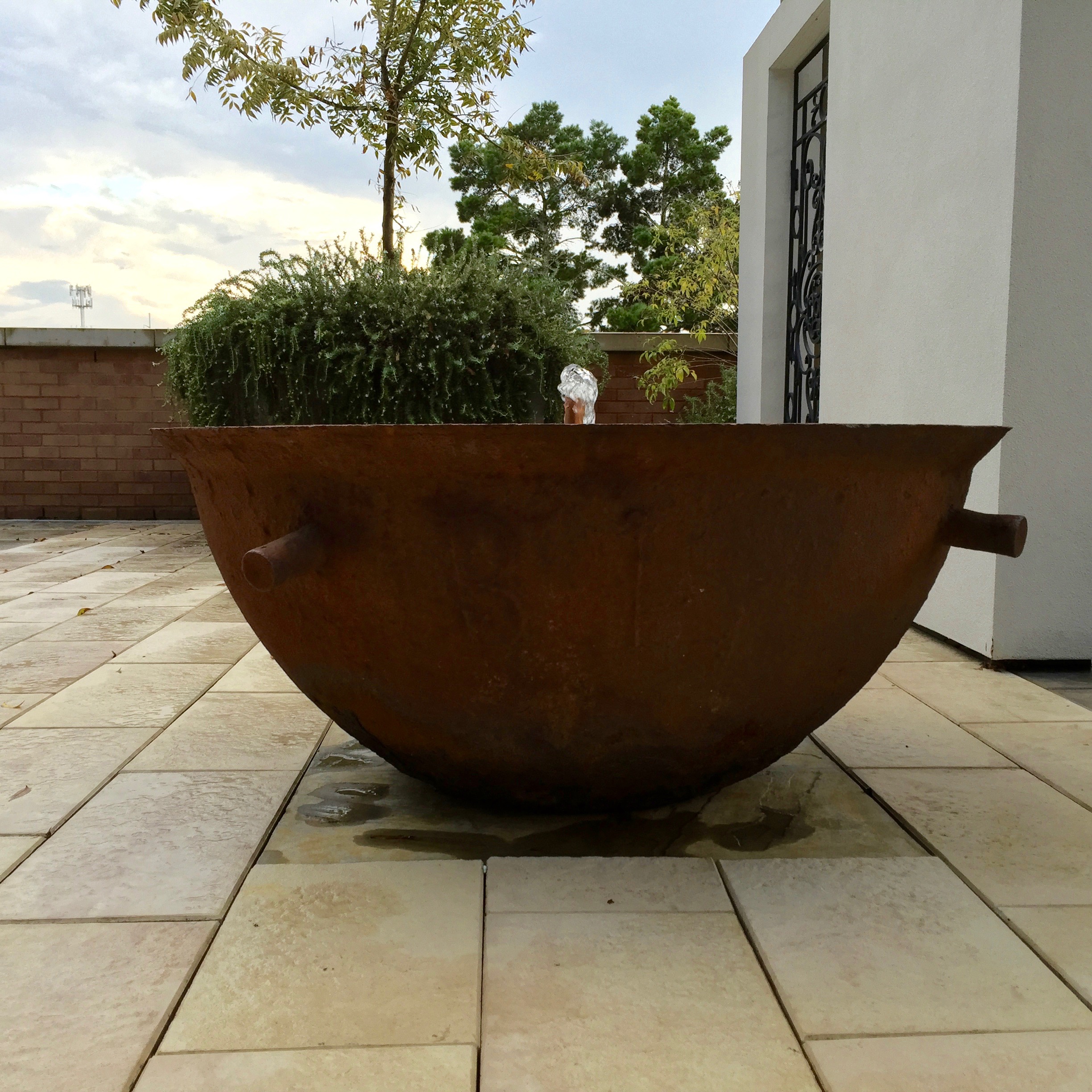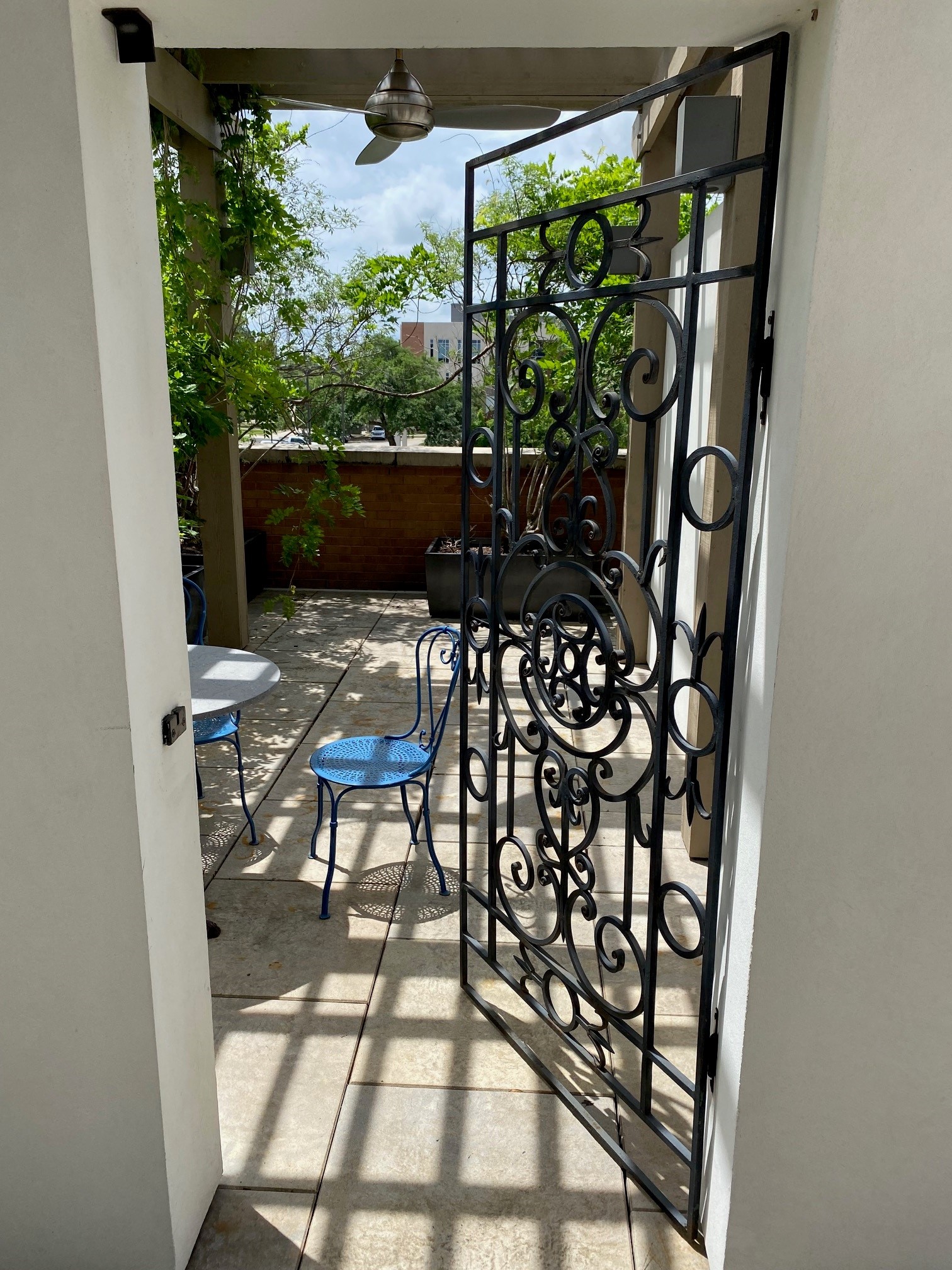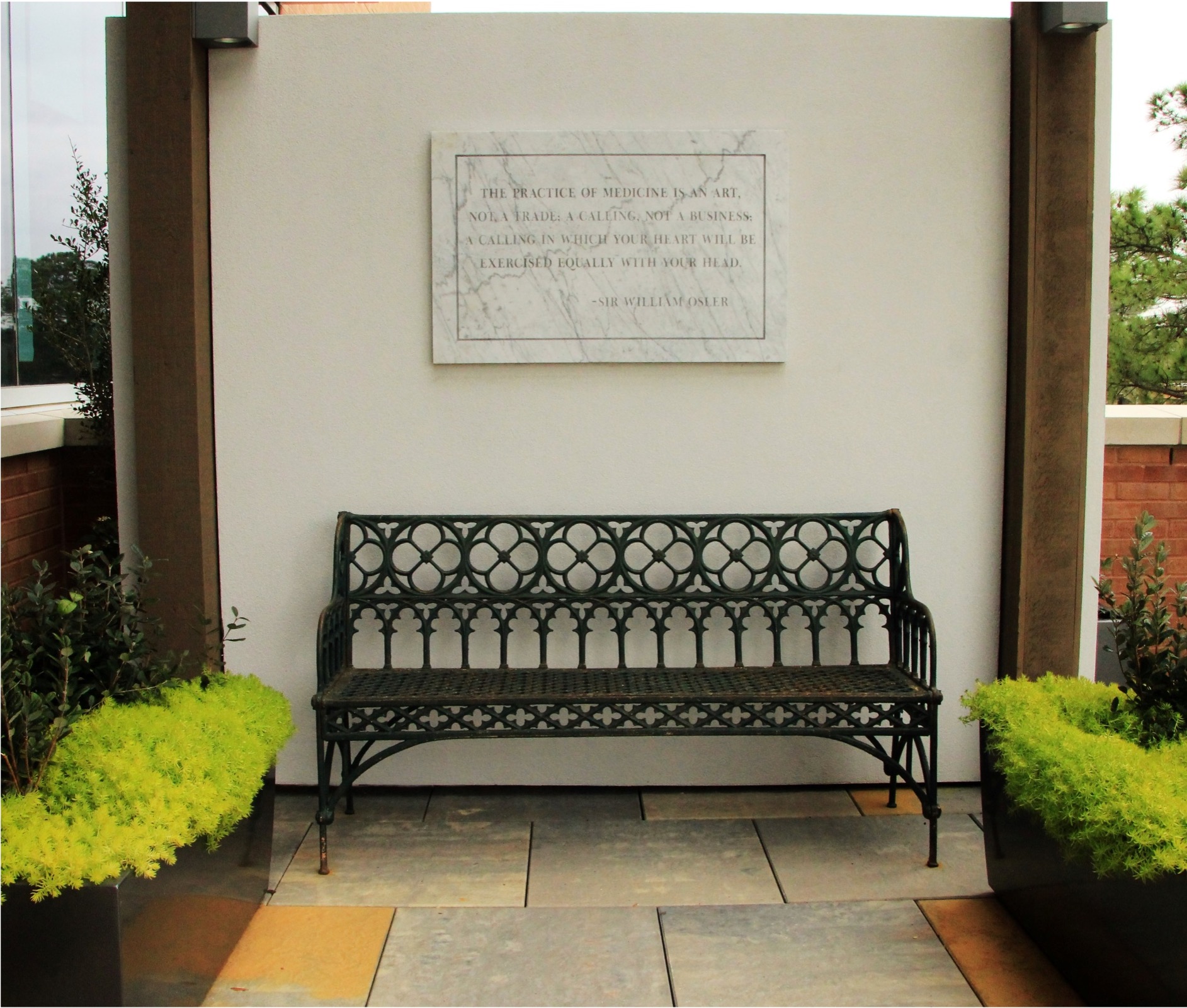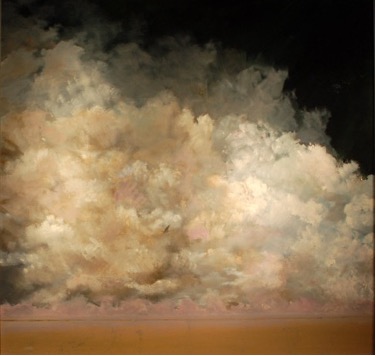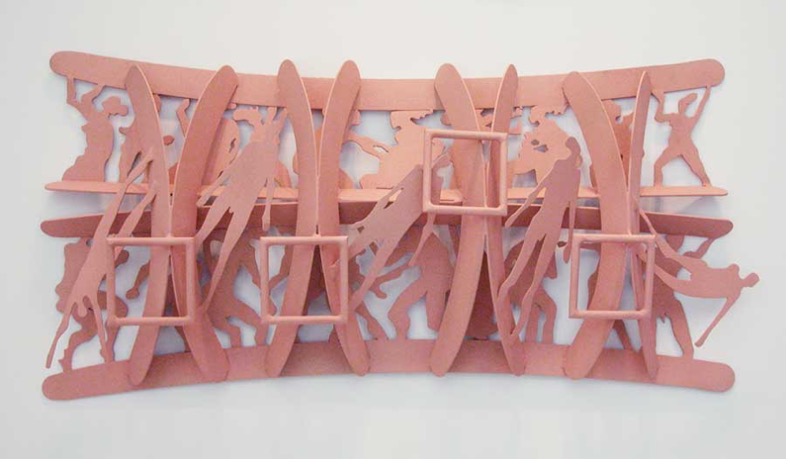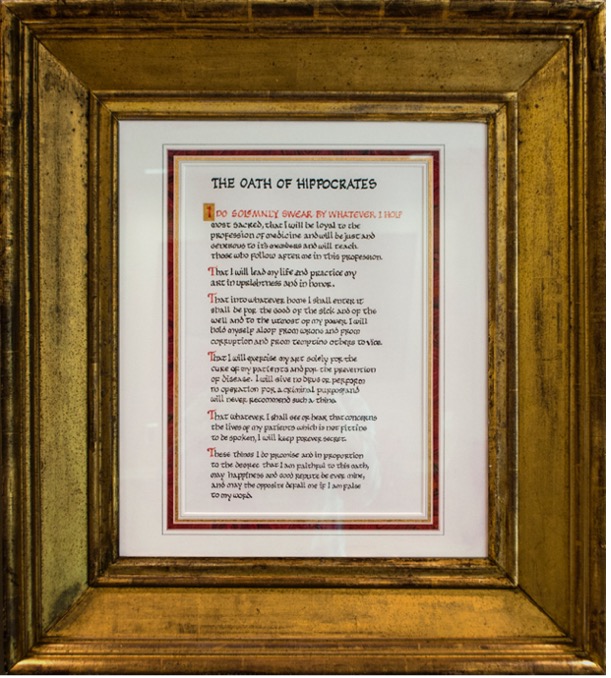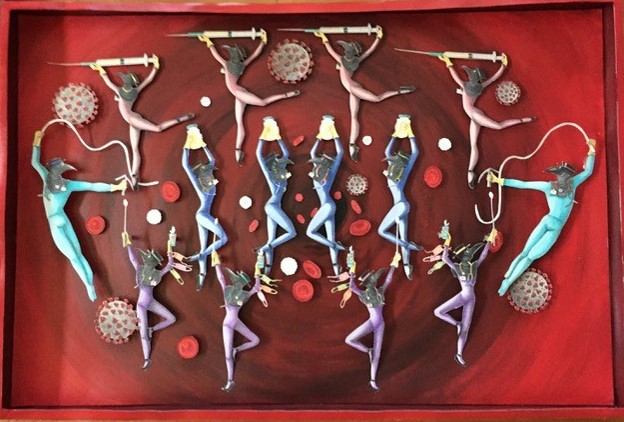The MEIC Culture Tour
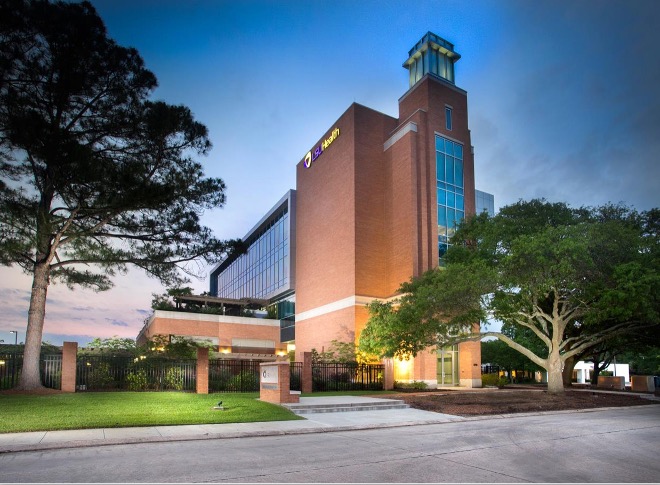
The practice of medicine is an art, not a trade;
a calling, not a business; a calling in which
your heart will be exercised equally with your head.
-Sir William Oslo, The British Medical Journal, 1903
The art and architecture of the LSU Health Medical Education and Innovation Center (MEIC) are unique components of the medical education initiative in Baton Rouge. The teaching environment is designed to impart a sense of place and importance, influencing the pursuit of excellence and professionalism. The building has familiar architectural features inspired by LSU’s main campus, such as the Campanile and Greek Theatre, and elements that recall Louisiana’s history of medical education, namely Charity Hospital and Earl K. Long Medical Center, while the landscaping includes plants indigenous to the area. Interior rooms and outside terraces are furnished with antiques and artworks, most which were created by Louisiana artists, that encapsulate the bearings of Hippocrates and Aesculapius as well as the core values of a noble medical profession. The MEIC strives to balance the rigor of clinical practice with the healing powers of art through a humanistic approach to medical education.
Architecture: Rebel Roberts
Landscape Design: Suzanne Turner
Philosophy Curation: George Karam
Text Panels: Elizabeth C. Weinstein
Web Design: Natalie Worsham
Special thanks to:
Brad Bourgoyne, Bourgoyne STUDIO, LLC, Baton Rouge
Patrick Dunne, Lucullus Antiques, New Orleans
Amy Finkel, M. Finkel and Daughter, Philadelphia
Dave Goodman, David Goodman Fine Furniture, New Orleans
Taylor Clark and George Clark, Taylor Clark Gallery, Baton Rouge
Pat Bacot (1941-2020), Emeritus Professor of Art History at LSU and Executive Director
of the LSU Museum of Art
And the many donors, artists, and advocates who contributed to this project’s success
First Floor
Hippocrates, c. 1680-1720
Carrara marble
Gift of the donors of the SAEC Fund of the Baton Rouge Area Foundation, in honor of their's father's career focused on humanism, idealism, and mentoring. Loaned to the MEIC by the Baton Rouge Area Foundation’s Telemachus Collection to Foster Humanism in Medical Education.
Carved out of Carrara marble by an unknown sculptor, the ancient Greek physician Hippocrates (c. 460-370 BC) is depicted confidently holding a medicinal cup. Hippocrates is often called the Father of Western Medicine because he was the first to theorize that diseases are caused by natural and not spiritual causes. Although debated today, he was credited in ancient times as the author of The Hippocratic Corpus, a collection of around seventy early medical works, including the Hippocratic Oath. Before being purchased for the MEIC, this antique statue was cherished throughout the nineteenth and twentieth centuries by a family of French physicians in Lyon. The base of the sculpture was designed by Greg LaCour using the mathematical principle called the Golden Ratio, also known as Divine Proportion. The ratio is equal to approximately 1:1.61. Following LaCour’s design, Gary Hart built the 16 x 10-inch steel base and then treated it to simulate bronze.
Brad Bourgoyne
Reproduction of Louisiana At Work and Play, 2014
Enrique Alférez, Charity Hospital Commission, 1939
Bronze
This reproduction by Brad Bourgoyne is of one of Enrique Alférez's (1901-1999) most significant works of art and acts as a symbolic connection between the MEIC and the historic Charity Hospital in New Orleans, which operated as a teaching facility for nearly two-hundred years. The original aluminum grille was commissioned in 1939 as a decorative architectural element for the hospital entrance. With permission from the artist’s estate, Brad Bourgoyne was commissioned to make a replica. Using a vertical man-lift and a portable 3D scanner, Bourgoyne created an exact digital image in a reduced size and then carved a model in foam with a computer-controlled router. After hand-detailing, the model was used to make a wax mold for bronze casting. The finished piece was cast in four parts in a Florida foundry and weighs 980 pounds.
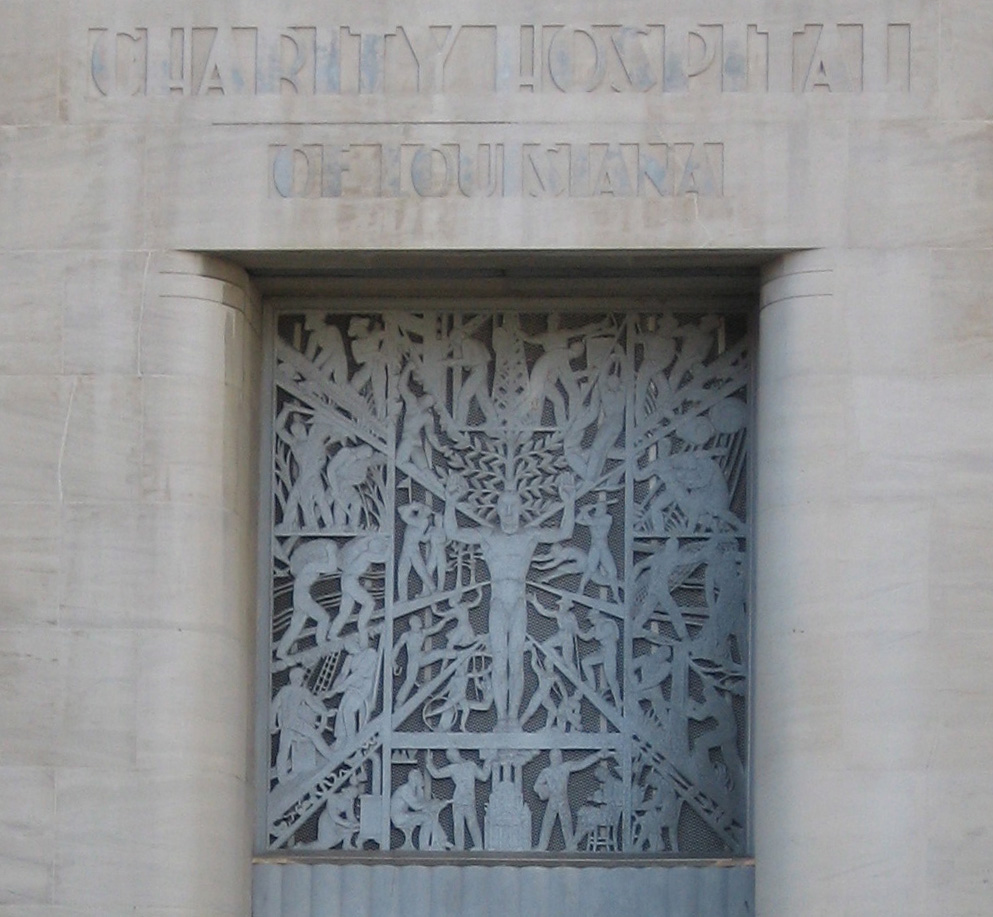
The original author is Wikimedia Commons author Infrogmation, CC BY-SA 4.0 <https://creativecommons.org/licenses/by-sa/4.0>, via Wikimedia Commons.
The original Louisiana At Work and Play was a State commission carried out by Enrique Alférez to embellish the entrance of Charity Hospital and is the most iconic work of public art related to healthcare in Louisiana. Measuring 13 feet high and 12 feet wide, the aluminum grille has a heroic stance and modern feel typical of the Art Deco style popular in the 1930s. Its design encompasses a large central male figure surrounded by an inner grid composed of scenes of people involved in recreational activities and an outer grid depicting people engaged in various types of work. The flying duck to the right of the central figure is a tongue-in-cheek reference to the salary deduction system used by Governors Huey Long and Richard Leche. On days when state employees were required to contribute, word was passed that “de-ducts were flying.”
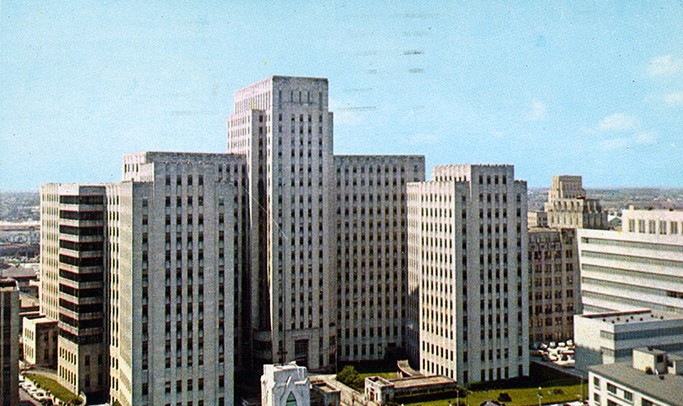
Big Charity,” c. 1968, New Orleans Public Library, Postcard Collection – Hospitals, #8
Charity Hospital was the second oldest continuously operating public hospital in the United States until 2005. Originally named “Charity Hospital for the Poor,” the medical facility’s tradition of caring for the indigent is attributed to French shipbuilder Jean Louis who provided the funds to open the first building in 1736. Its long history as a teaching hospital began in 1834. The hospital operated out of several buildings over time, but by the 1930s a new building was badly needed. The facility on Tulane Avenue in New Orleans was built between 1936 and 1940. The massive Art Deco-style building was designed by Weiss, Dreyfous and Seiferth, the same architectural firm as the “new” Louisiana State Capitol in Baton Rouge. Both buildings encompass a towering “skyscraper” composed of a steel-frame clad with Alabama limestone. Charity Hospital was forced to close in 2005 due to extensive damage from Hurricane Katrina.
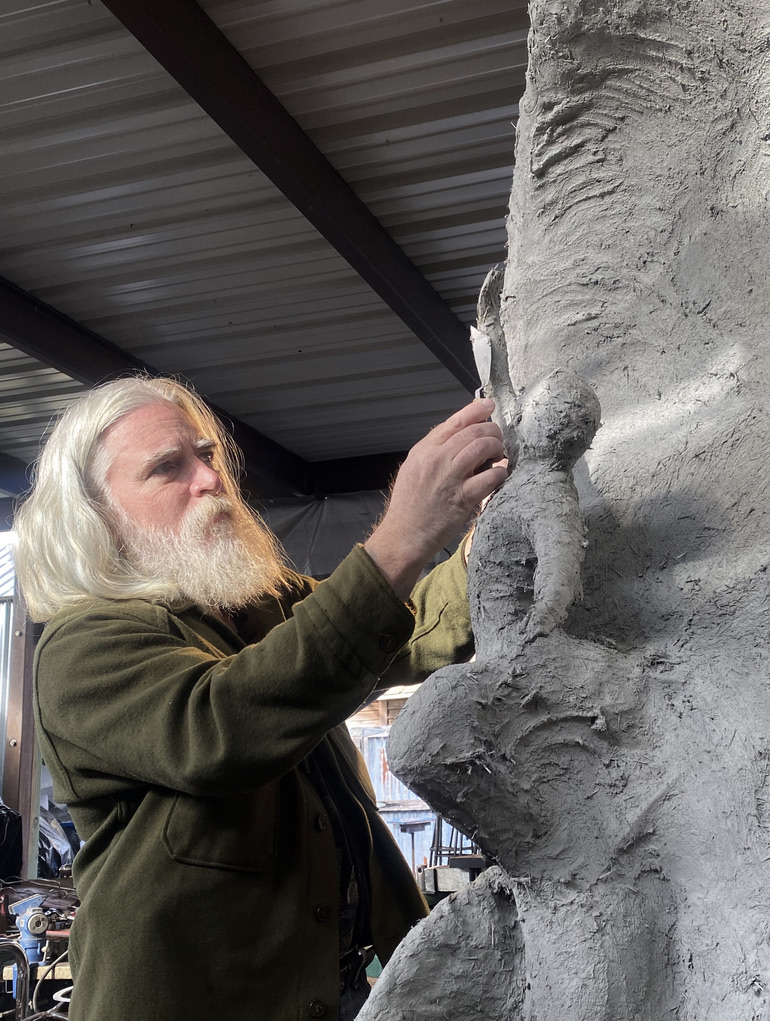
Image reproduced with permission of the artist.
Brad Bourgoyne is known for his unique practice of combining traditional and digital media to make figurative sculptural forms. A native of Baton Rouge, he received his Bachelor of Fine Arts degree summa cum laude from Louisiana State University in 1993. He began making sculpture while pursuing his Master of Fine Arts degree at the University of Connecticut, Storrs, and graduated in 1995. Bourgoyne later taught part-time at LSU while continuing a private study of traditional figural arts including the age-old technique of bronze casting known as cire perdu, or lost wax. After joining his family’s engineering firm as a computer artist, he realized the potential of combining these traditional methods with digital software and equipment such as 3D scanners and printers to make compelling sculptural works.
Robert W. Douglass
First Born, c. 1903
Gouache on paper
This scene shows a nervous father sitting in a hospital waiting room anxiously awaiting the arrival of his first-born child. Painted by Robert W. Douglass (1918-1980), the picture was published as an illustration for an article in the Saturday Evening Post, most likely in the 1930s. Its realistic style and everyday subject matter recall the work of another artist Norman Rockwell, who became famous for his depictions of American life and like Douglass was also a regular contributor to the Saturday Evening Post. Douglass became well-known for his talent. He was an illustrator for a number of magazines, including Cosmopolitan, Good Housekeeping, Life, McCall’s, and others.
Second Floor
George Dunbar
Coin du Lestin, 2000
Black and gray clay
Gift of Chester Chattin “Chet” Coles, MD (LSU School of Medicine in New Orleans, Class
of 1973) and the Coles Family in honor of George Dunbar.
Loaned to the MEIC by the Baton Rouge Area Foundation’s Telemachus Collection to Foster
Humanism in Medical Education.
George Dunbar (1927-2024) is well-known for his elegant paintings built of many layers of colored clay, some of them finished in gold leaf. This work is one of over two-hundred versions from his ongoing series titled Coin du Lestin. A land developer as well as an artist, the series is named after a project in Slidell, where he lives. The methodically incised design recalls the circular form of a sacred Buddhist mandala as well as the ancient Celtic symbol called the Dara Knot. Inspired by the root system of the oak tree, the Dara Knot symbolizes inner strength and wisdom as well as community. The stark geometry of the incised emblem plays against the subtle imperfections and irregularities of its earthy materials.
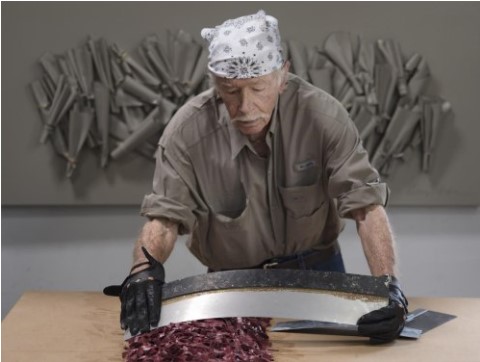
Image reproduced with permission of Callan Contemporary; photographer, Cameron Wood.
George Dunbar was born in New Orleans in 1927. He studied at the Tyler School of Art at Temple University and later received a BFA in painting from the Académie de la Grande Chaumière in Paris in 1953. That same year he was honored with his first solo exhibition in Philadelphia. His work has since been exhibited around the world and is included in many museum collections, among them the British Museum in London, the Whitney Museum of American Art in New York and closer to home at the Ogden Museum of Southern Art and the New Orleans Museum of Art. His many accolades include the Governor's Lifetime Achievement Award in 2008, the Opus Lifetime Achievement Award from the Ogden Museum in 2002, and the Delgado Society of the New Orleans Museum of Art's Distinguished Art Award in 2001.
Frank Hayden
Study for Marche de Galvez, c. 1976-79
Plaster
Loaned to the MEIC by the Baton Rouge Area Foundation’s Telemachus Collection to Foster Humanism in Medical Education.
Frank Hayden made this plaster study while working out his ideas for a commission for the city of Baton Rouge honoring Baton Rouge’s Bicentennial celebration in 1976. He chose to depict Spanish Governor Bernardo de Galvez’s famous march into the city in 1783 to capture the British Fort. At the helm is New Orleans merchant Oliver Pollock, who led the march, followed by his troop composed of people from different races and various countries. Incorporated into the imagery are phrases taken from The Capture of the Bluff at Baton Rouge by Galvez, the first poem published in Louisiana in 1779. Written by Julien Poydras, the words translate as: left - "What mortal or god comes here in his rage to trouble the peace of my happy banks"; right – "You left your fields, children, wives, brave warriors, champions of my glory"; and within Pollock’s hood – "It was with your hands that today I won my victory." The victory destroyed British hopes of capturing New Orleans and controlling the Mississippi River, an important moment in the fight for American independence.
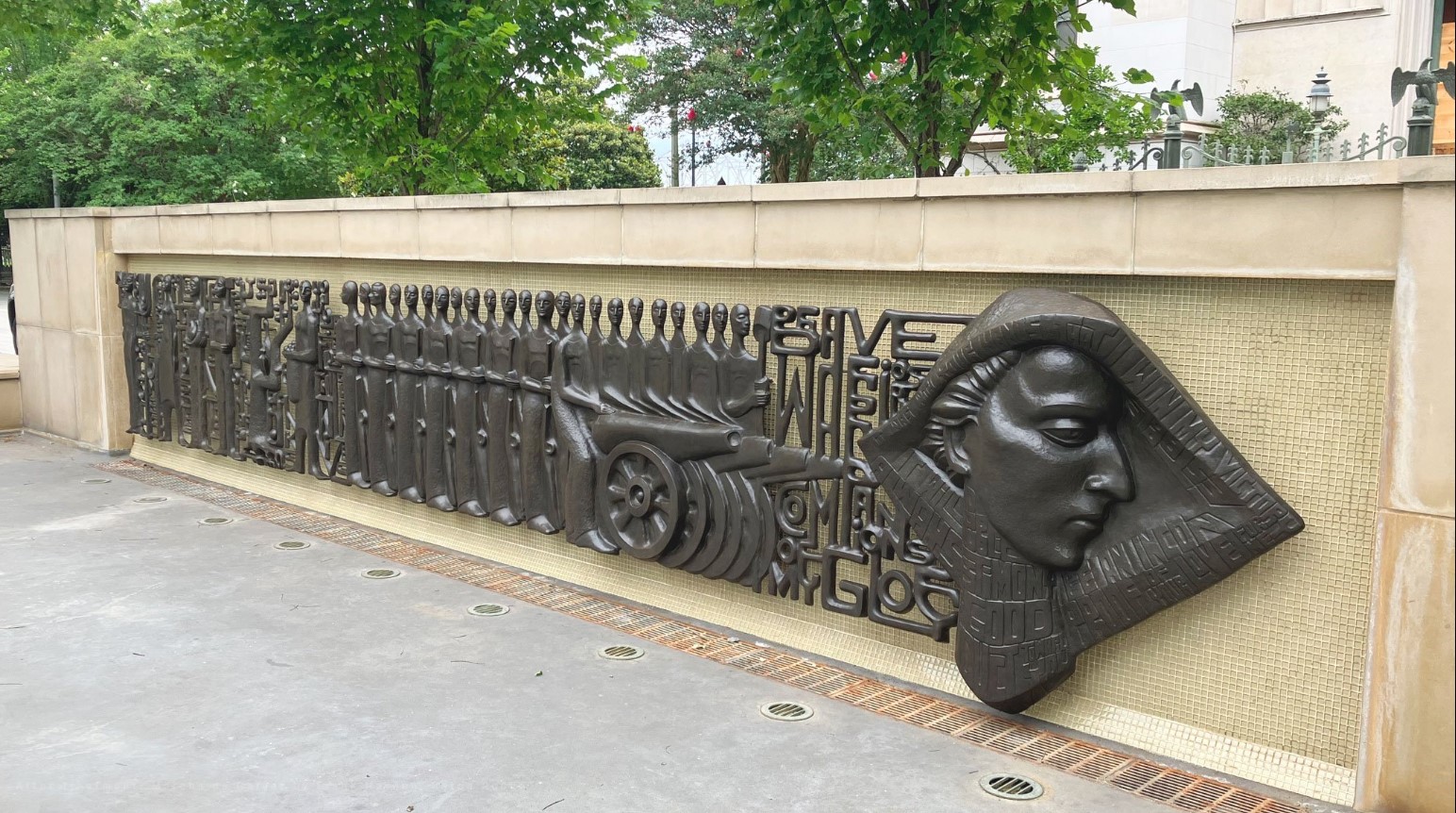
Image reproduced with permission of Anders Art Conservation
Frank Hyden’s public works made in honor of Baton Rouge’s Bicentennial dominate Baton Rouge’s downtown landscape. His 30-foot-long bronze frieze titled Marche de Galvez depicts Spanish Governor Bernardo de Galvez’s famous march in 1783 to capture the British Fort in Baton Rouge. The frieze is accommodated by another sculpture, a colossal 10-foot-tall Head of Oliver Pollock, the New Orleans merchant who led the march. Both works are installed in the green space known as Galvez Plaza located between the Baton Rouge Public Library and Louisiana’s Old State Capitol. The plaza was dedicated on the 200th anniversary of the historic Marche de Galvez on September 21, 1979. The plaza has since been redesigned as a public entertainment venue with a permanently installed stage erected near Hayden’s monuments.
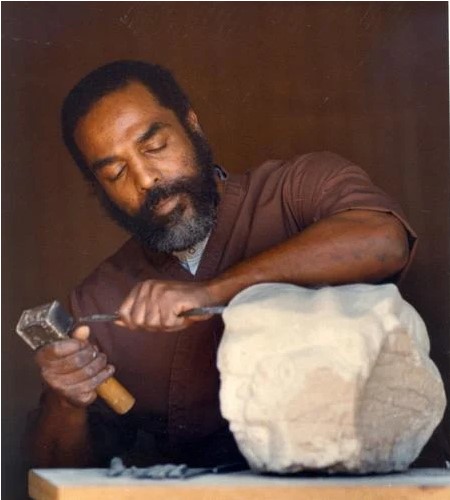
Image reproduced with permission of the Hayden Family.
Frank Hayden (1934-1988) is among Louisiana’s most prominent sculptors. He is best known for his public commissions statewide, many of which may be found in churches, synagogues, and banks throughout Baton Rouge. Born in Memphis of humble means, he earned an academic scholarship to Xavier University in New Orleans, where he first encountered sculpting. He graduated in 1957 with several scholarships to graduate programs throughout the country. He chose to attend the University of Notre Dame, opting to study under noted Croatian sculptor Ivan Meštrović (1883–1962). Hayden completed postgraduate work at Iowa State University and won several fellowships over the ensuing years enabling him to study in Europe. In 1962, he joined the faculty of Southern University in Baton Rouge where he taught sculpture and drawing for twenty-seven years. In 1985, the faculty honored him with the university’s first Distinguished Professor award. Hayden died tragically at age 53.
Aesculapius, French, c. 1825
Silk embroidery over watercolor
This antique watercolor embroidered with silk chenille and metallic thread depicts a physician being crowned with a laurel wreath by Aesculapius, identified by his staff with a single snake as the god of medicine. The suited man being honored is French physician Louis Le Roy (1766-1842), whose publication La Médecine Curative (Healing Arts, 1825) is held in the hand of a trumpeting angel above his head. The three masked men hiding unsuccessfully reference another book authored by Le Roy titled Le Charlatanisme Démasqué (Quackery Unmasked, 1819). During the late eighteenth and early nineteenth centuries, the rapid advancement of investigative methods in scientific research prompted pseudo-doctors to devise their own alternatives to academic medicine. This artwork illustrates the importance of competency and avoidance of quackery in an honorable medical practice and serves as an inspirational scene at the entrance to the MEIC’s Simulation Center. This museum-quality piece was acquired through the assistance of Amy Finkel (of M. Finkel & Daughter, Philadelphia, PA), who is widely considered to be America's leading expert in the field of antique samplers and needlework.
The Reconciliation Room
The Reconciliation Room reflects the “heart” of the MEIC and connects the building’s various classrooms, workspaces, and meeting rooms with the essence of the MEIC’s philosophical approach. This special room is a place where students and teachers come to decompress, gain perspective, reflect, mentor, and reconnect. The architects designed the room to be circular to signify wholeness, harmony, and a lack of hierarchy while the wood paneling imparts a sense of warmth, comfort, and empathy. The vintage lantern served as inspiration for the impressive conference table inlaid with four different kinds of wood. These Art Deco-style furnishings symbolically link the MEIC with the historic Charity Hospital building in New Orleans, which served as a medical teaching facility for centuries. Artworks by Louisiana artists connect the origins of medical practice with Louisiana’s own history and modern philanthropy in support of medicine and graduate medical education.
Dave Goodman
Conference Table, 2013
White oak, sapele, walnut, and maple woods
Image reproduced with permission of the artist and Carol Robinson Gallery.
Dave Goodman was commissioned by the MEIC to make the impressive conference table in the Reconciliation Room. Inspired by the vintage French lantern hanging above, he masterfully handcrafted the 10-foot round table inlaid with four different kinds of wood to reflect the warm tones and geometric lines of the lighting fixture. This contemporary twist on the Art Deco design style is reminiscent of that of Charity Hospital in New Orleans, which was a teaching hospital for centuries. Goodman also crafted the matching wood frames around designated artworks in the MEIC collection.
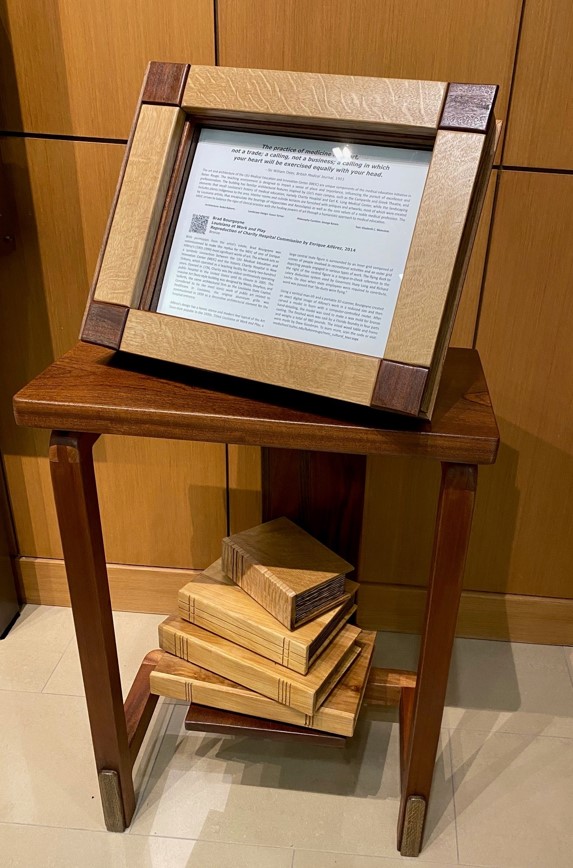
David Goodman Fine Furniture (New Orleans) has a reputation for fine handcrafted functional tables and decorative sculptural works that emphasize the beauty of wood, such as the two pedestals on the first floor of the MEIC building. Designed by Dave to look as if they are holding actual books, these pedestals act as signage holders but also are works of art in and of themselves. Sometimes Dave makes pieces out of pristine wood purchased from lumber shops while at other times he composes work made from cypress and pine boards saved from late nineteenth century houses that he restores. Instead of working from plans or detailed drawings, he works intuitively. Dave builds his furniture pieces layer by layer, sometimes from the top down and at other times from the legs up. Goodman lives and works in New Orleans.
French Art Deco Lantern, c. 1935
Leaded glass and bronze
The lighting in the Reconciliation Room emanates from a vintage French lantern, purchased from Carlos de la Puente Antiques in New York City. Designed in the Art Deco style with elements reminiscent of Art Nouveau, this fixture with its eight-sided lead glass panes may be interpreted as shedding light upon multiple ways of seeing. Art Deco was an international design style popular in the 1930s and applied to everything from jewelry and furniture to architecture. In Baton Rouge, the architectural firm of Weiss, Dreyfous and Seiferth has to its credit the Art Deco Charity Hospital building as well as the Louisiana State Capitol. At the top of the Capitol’s 450-foot tower is a temple-like structure topped by a massive lantern conceived by the architects in their words as sending forth “the Light of Hope, the Light of Faith, the Light of Highest Knowledge.”
Enrique Alférez
Study for La Guiá (The Guide), 1982
Charcoal on butcher paper
Funded by the Merck/Joe S. Mowad Endowment for Humanism in Medical Education Fund of the LSU Health Foundation.
This drawing was made by esteemed sculptor Enrique Alférez . A child is depicted sitting in the lap of an adult, presumably a parent. Mirroring the elder’s stance, the bare-chested child is in a position of complete emotional and physical vulnerability. With vulnerability, trust can develop, culminating in an aptitude for being guided and mentored. The drawing is a study and was made in preparation for a stone sculpture of the same title that resides at the Alférez family home in Morelia, Michoacán, Mexico.
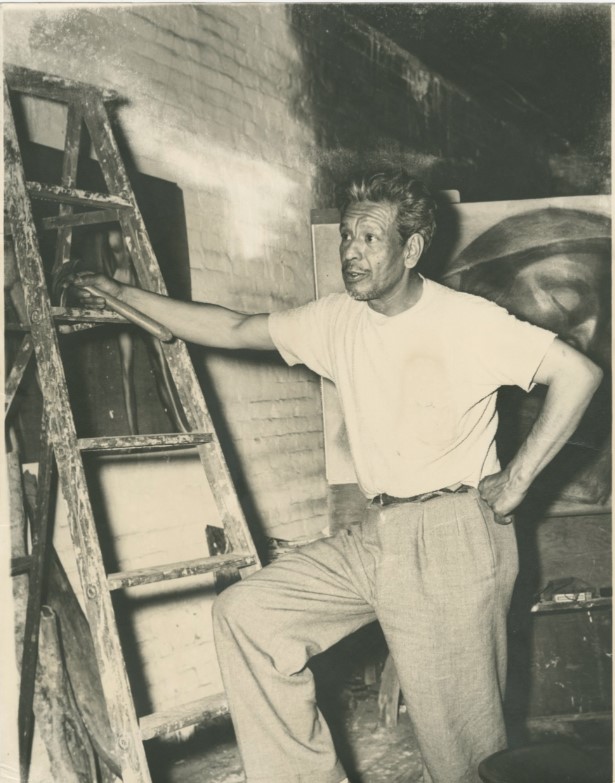
Jules L. Cahn, Enrique Alférez, April 1953, The Historic New Orleans Collection, 1996.123.3.6.
Enrique Alférez (1901-1999) was born in Zacatecas, Mexico, and served for ten years as a youth in the Mexican Revolution. After escaping, he made his way to El Paso, Texas and eventually went north. Deciding to pursue a career in art, he enrolled in the Art Institute of Chicago, where he studied under famed sculptor Lorado Taft. On his way to Mexico in 1929, he stopped in New Orleans, where he remained for the next seventy years. Alférez became a leading figure in the art community and played a major role in the Works Progress Administration’s public art initiatives, many of them carried out by the architectural firm Weiss, Dryfous and Sieferth. He worked with the firm on several WPA projects including Charity Hospital in New Orleans, and two large fountains, one in New Orleans City Park and another at the entrance to New Orleans Lakefront Airport. Among his many additional commissions for public art in New Orleans are those for the Louisiana State University Medical School and Touro Infirmary, both in New Orleans.
Angela Gregory
Head of Aesculapius, c. 1929-30
Plaster
Funded by the Merck/Joe S. Mowad Endowment for Humanism in Medical Education Fund of the LSU Health Foundation.
This depiction of Aesculapius, the Greek god of medicine, was made by Angela Gregory, the first woman sculptor in Louisiana to achieve international recognition. One of several plaster studies, it was made in preparation for a larger limestone version that she carved for the entrance to the Hutchinson Memorial Building, which houses Tulane University’s School of Medicine New Orleans. In Greek mythology, Aesculapius was a mortal hero who eventually came to represent the healing aspect of the medical arts and was among the most popular of the ancient gods.
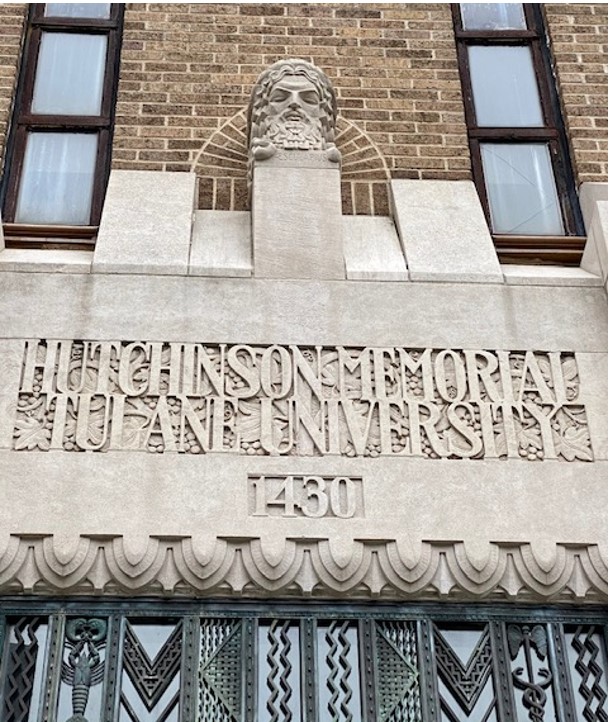
Angela Gregory (1903-1990) was commissioned to make a sculpture in place of the keystone above the entrance to the Hutchinson Memorial Building in New Orleans that houses Tulane University’s School of Medicine. Given the freedom to decide upon the subject matter, she chose to depict the head of Aesculapius, the god of medicine. To compose her visualization of the ancient healer, she drew inspiration from a collection of statuettes owned by a physician she knew and a bearded man whom she asked to model for her. After making several versions, Angela carved a scale model out of plaster to demonstrate the final design. She then carved the large limestone Head of Aesculapius in her Pine Street studio. It was installed on the Tulane Avenue building in 1931.
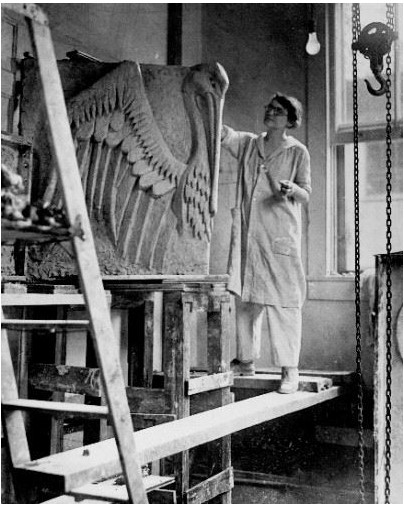
Image reproduced with permission of Angela Gregory, LLC.
Angela Gregory was the first woman in Louisiana to receive international recognition as a sculptor. The daughter of an artist and a hydraulics engineer, Angela was born in New Orleans in 1903. She resolved to “learn to cut stone” at the young age of 14. After graduating from Newcomb College, she studied at Parson’s School of Design in Paris and, in 1926, became the only American and one of few women ever to study in the private studio of Antoine Bourdelle, protégée of the famous sculptor August Rodin. Returning home to New Orleans, Angela established a studio behind her family home, where she spent the next sixty years creating sculptural works for many important architectural buildings of her day, including the Louisiana State Capitol, and three monuments. A teacher, mentor, and trailblazer, Angela Gregory died in 1990.
Brad Bourgoyne
Paula Garvey Manship, 2013
Bronze
Brad Bourgoyne produces realistic sculptural portraits by combining traditional and digital media. This commissioned sculpture is a likeness of Paula Garvey Manship (1912-2006), a Baton Rouge philanthropist and community leader. Coined by Greek playwright Aeschylus in the 5th century BCE, the term philanthropy translates as “love of humanity.” Mrs. Manship was particularly devoted to Louisiana State University. Among her many gifts, she endowed the Chair of Medical Education named in her honor within the LSU Health Sciences Center's Department of Internal Medicine Residency in Baton Rouge. Another bronze sculpture of Paula Garvey Manship by Bourgoyne is on display in the lobby of the Shaw Center for the Arts downtown.

Image reproduced with permission of the artist.
Brad Bourgoyne is known for his unique practice of combining traditional and digital media to make figurative sculptural forms. A native of Baton Rouge, he received his Bachelor of Fine Arts degree summa cum laude from Louisiana State University in 1993. He began making sculpture while pursuing his Master of Fine Arts degree at the University of Connecticut, Storrs, and graduated in 1995. Bourgoyne later taught part-time at LSU while continuing a private study of traditional figural arts including the age-old technique of bronze casting known as cire perdu, or lost wax. After joining his family’s engineering firm as a computer artist, he realized the potential of combining these traditional methods with digital software and equipment such as 3D scanners and printers to make compelling sculptural works.
The Teaching Terrace
The Teaching Terrace at the MEIC is landscaped with plants, trees, and trellises designed to separate the space into several outdoor rooms designated for different purposes. The large Gathering Place and the Outdoor Classroom encourage active dialogue while the secluded seating areas in the Conversation Gardens and Reflection Cove inspire introspection. Art and antiques placed within these outdoor rooms not only beautify the terrace but act as a reminder of the positive role that art and nature play in the healing process.
Dale Chihuly
Red Reeds, 2014
Glass
Commission funded by Blue Cross/Blue Shield of Louisiana, the Terren Klein family, and the Bringing Something Back Program of the LSU Internal Medicine Residency in Baton Rouge in honor of the Bringing Something Back international elective (2007-2012). Loaned to the MEIC by the Baton Rouge Area Foundation’s Telemachus Collection to Foster Humanism in Medical Education.
The MEIC commissioned Dale Chihuly to make the glass sculpture installed on the far end of the Gathering Place on the Teaching Terrace. The Seattle-based artist is known worldwide for revolutionizing glassblowing as a sculptural technique. Inspired by nature, Chihuly’s colorful, organic forms resemble plants or sea creatures and are often placed in garden settings. The MEIC’s sculpture is one of several titled Red Reeds. Its vibrant color recalls both the historic origin of Baton Rouge, whose name translates as “red stick”, as well as the symbolic association of the ruby gemstone with health and wisdom.
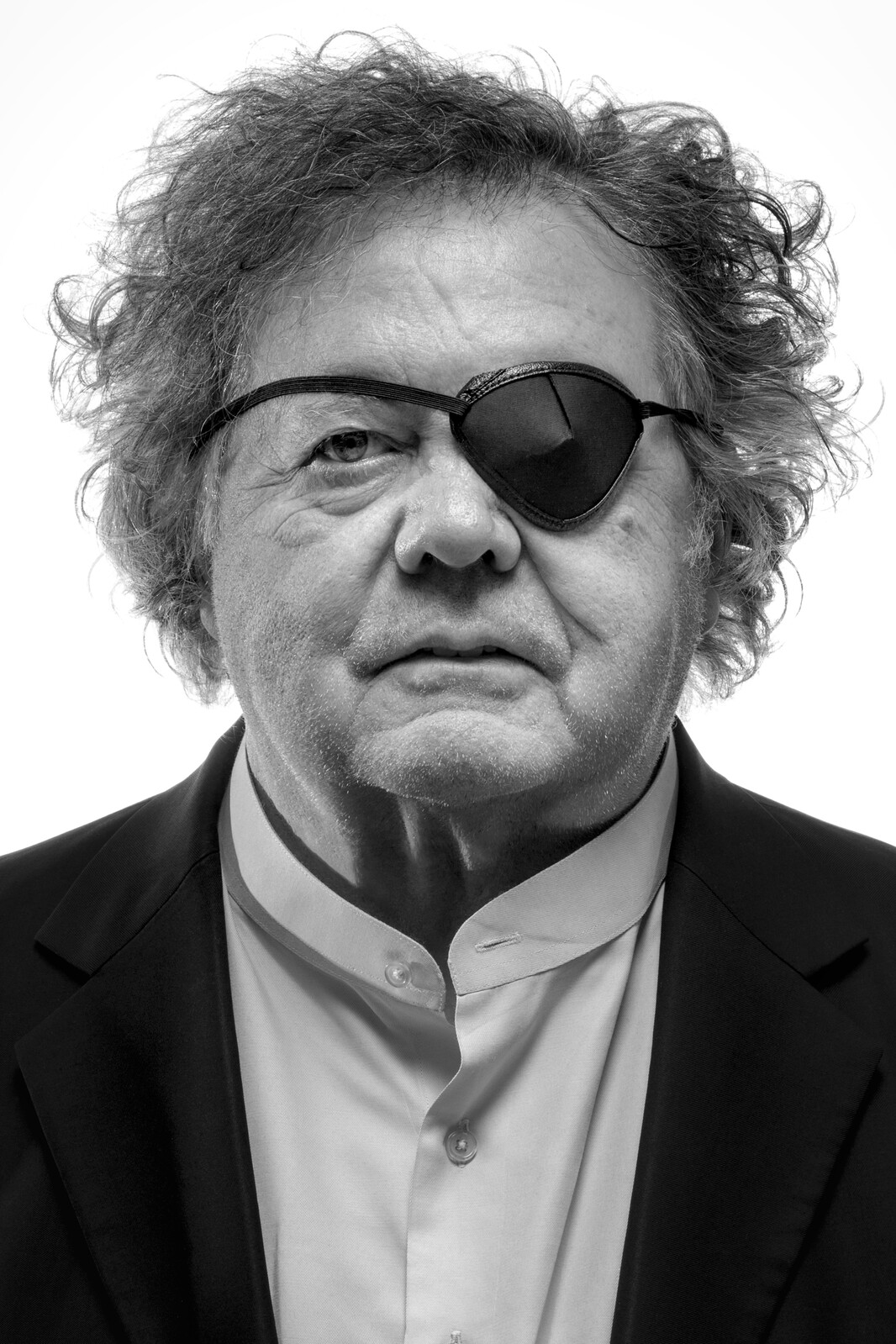
© 2024 Chihuly Studio / Artists Rights Society (ARS), New York.
Dale Chihuly is leader in the development of glass as a fine art. Born in 1941 in Tacoma, Washington, Dale Chihuly was introduced to glass while studying interior design at the University of Washington. After graduating in 1965, Chihuly enrolled in the first glass program in the country, at the University of Wisconsin. He continued his studies at the Rhode Island School of Design (RISD), where he later established the glass program and taught for more than a decade. In 1968, after receiving a Fulbright Fellowship, he went to work at the Venini glass factory in Venice. There he observed the team approach to blowing glass, which is critical to the way he works today. In 1971, Chihuly cofounded Pilchuck Glass School in Washington State. His work is included in more than 200 museum collections worldwide. He has been the recipient of many awards, including two fellowships from the National Endowment for the Arts and twelve honorary doctorates.
Outdoor Classroom
Inspired by gardens in Italy, the Outdoor Classroom on the Teaching Terrace is housed under a picturesque loggia. On a tiled patio students sit on Napoleon III period garden chairs at an antique French table topped with a green Italian marble slab that formerly adorned the altar space of Christ the King Catholic Student Center on Louisiana State University’s campus.
Louisiana Sugar Kettle, c. 1775-1800
In honor of Cary and Zelda Long, whose efforts led to the funding of the Paula Garvey Manship Chair for Medical Education. Loaned to the MEIC by the Baton Rouge Area Foundation's Telemachus Collection to Foster Humanism in Medical Education.
Near the Outdoor Classroom is a rare sugar kettle dating from around the last quarter of the eighteenth century. This kettle was formerly owned by Cary and Zelda Long. Its prominent placement pays tribute to the importance role that the Longs played in the establishment of the Paula Garvey Manship Chair for Medical Education within the Louisiana State University Health Sciences Center's Department of Internal Medicine in Baton Rouge.
Conversation Garden
Belle Epoque Gates, c. 1871-1914
Iron
The MEIC’s Conversation Gardens are discreet spaces set in nature and designed to stimulate emotional awareness and open communication, essential qualities in a medical practice rooted in humanism. Hidden behind white stucco walls, one is beside the Outdoor Classroom and the other is just beyond the Dale Chihuly sculpture in the Gathering Place. These private spaces were designed to incorporate matching antique French gates, whose graceful, sinuous curves are indicative of the Art Nouveau style in the Belle Epoque period. These gates were purchased in France through the assistance of Patrick Dunne of Lucullus Antiques in New Orleans, and the Conversation Gardens were designed to incorporate the gates. These private nooks follow a tradition begun at Earl K. Long Medical Center in Baton Rouge when medical education was conducted there.
Reflection Cove
Antique French Bench, 1830
Funded by the Merck/Joe S. Mowad Endowment for Humanism in Medical Education Fund of the LSU Health Foundation.
Secluded seating areas set in nature are a traditional feature of “Italianate Garden” design. These quiet nooks inspire contemplation. Some feature a philosophoical message, such as those in Ravello, Italy, that act as a reminder of the many artists and poets who have been lured to the beauty of the Amalfi Coast. The MEIC’s contemporary version of such a Reflection Cove has an antique garden bench above which a quote. Taken from Sir William Osler's 1903 lecture at the University of Toronto’s medical education facility, it states: “The practice of medicine is an art, not a trade; a calling, not a business; a calling in which your heart will be exercised equally with your head.”
Third Floor
Robert Seago
Clouds, n.d.
Oil on canvas
Robert Seago was a prolific artist who enjoyed depicting the beauty of the rural Louisiana landscape, among other themes. This painting focuses upon the stratocumulus clouds billowing over the seemingly endless Louisiana marshland. Ancient agrarian cultures were dependent upon rain and believed clouds to be created by gods or divine spirits. As such, clouds represented the cycle of life and death. Stratocumulus clouds, identified by their low-lying clumped composition, are a symbol of safety and comfort.
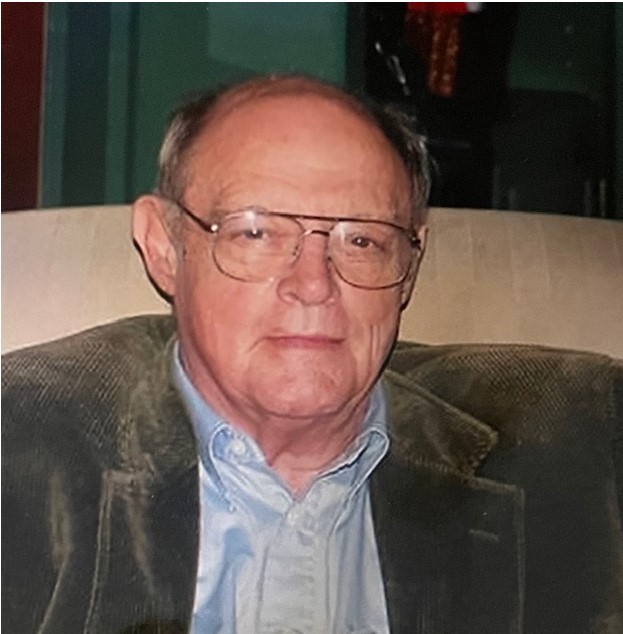
Image reproduced with permission of Judith Seago.
Robert Seago (1936-2020) was a prolific artist who enjoyed depicting the beauty of the rural Louisiana landscape, among other themes. He studied under Jim Steeg, former chairman of Newcomb College at Tulane University, and later with Auseklis Ozols, founder of the New Orleans Academy of Fine Arts. In the mid 1980's, he moved with his wife to Covington, Louisiana, where he opened Seago Art Galleries. His paintings, drawings and etchings are found in numerous private and public collections
Fourth Floor
John T. Scott
Urban Dense Pack #2, 2005
Copper-coated aluminum
John T. Scott is celebrated as one of America’s most innovative artists. Shaped in part by African, Caribbean, and New Orleans musical traditions, Scott worked in an improvisatory style similar to that of a jazz musician. Scott listened to music while he worked, finding inspiration in the way jazz musicians intuitively select notes that individually do not make sense but constitute a unique and harmonious whole when played together. His work is often described as “optical jazz” or “visual blues.” A master of many art mediums from welding to printmaking, Scott is best known for his public sculpture, much of which is in New Orleans.
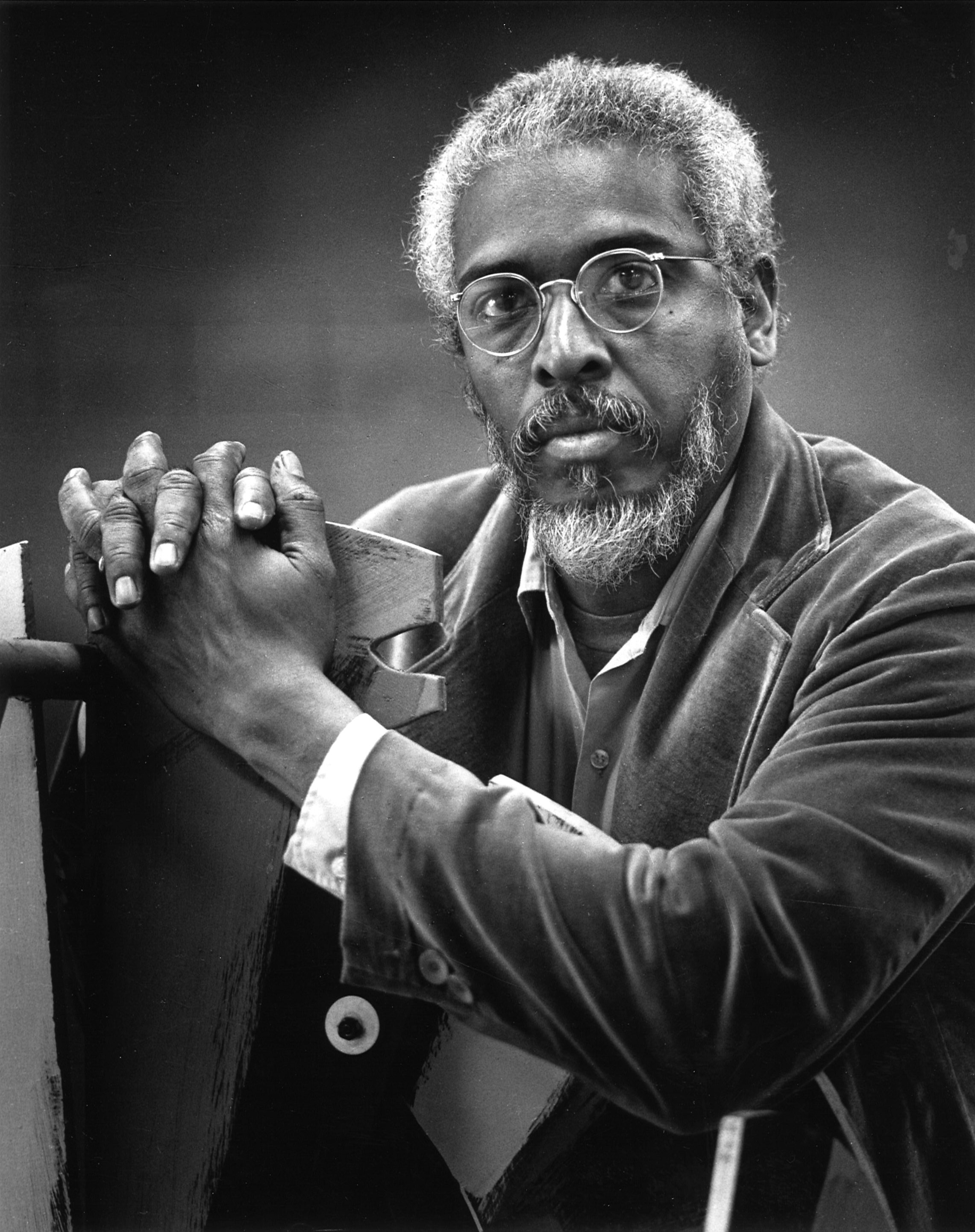
Image reproduced with permission of Anna Rita Scott & The John T. Scott Artist Trust, and Arthuer Roger Gallery.
John T. Scott (1940-2007) was born in New Orleans and grew up in the Lower Ninth Ward. Although his beginnings were humble, his mother instilled in him that “whatever you did, you did well.” He attended Xavier University in New Orleans and subsequently Michigan State University, where he studied under Charles Pollock, brother of famous painter Jackson Pollock. After completing graduate studies in 1965, he accepted a teaching post at Xavier where he remained for more than forty years. A milestone in his career came in 1983 when he received a grant to study kinetic sculpture under George Rickey. From then on, his artistic output included sculptural works delicately balanced to be in motion. This new work brought him acclaim and in 1994 he became the first Louisiana artist to win a prestigious “genius” grant from the John D. and Catherine T. MacArthur Foundation. A versatile artist, Scott is best known for his public commissions in New Orleans. Scott died in Houston in at age 67 while recovering from a double-lung transplant operation.
Hippocratic Oath, 2013
Calligraphy: Milton Scheuermann
French Matting: Marla Hoppenstedt
Gilt Frame, c. 1810
Funded by the Merck/Joe S. Mowad Endowment for Humanism in Medical Education Fund of the LSU Health Foundation.
The earliest expression of medical ethics in the Western world, the Hippocratic Oath has been in existence since 400 BC and attributed to the ancient Greek physician Hippocrates. Often called the Father of Western Medicine, Hippocrates was the first to separate medicine from religion, believing ailments to be caused not by spiritual forces but by natural means. Despite modern debate over its authorship, the oath established a set of essential ethical values in medical practice, such as confidentiality and non-malfeasance which are of paramount significance today. Medical school graduates historically take a modernized version of the Hippocratic Oath, which originally began with an appeal to Aesculapius, the god of medicine.
Lee Brandt Randall
The Dance of the COVID-19 Fairies, 2021
Mixed media
Healthcare workers around the country worked tirelessly and selflessly to aid patients with life-threatening and fatal infections during the COVID-19 Pandemic. Inspired by the huge amount of time and emotional energy contributed by workers in the medical industry, Lee Brandt Randall composed this colorful, surrealistic scene out of a variety of artistic media including paper cut-outs. The artist then donated this artwork to the MEIC in tribute to the many LSU doctors and students who provided care to patients during the pandemic.
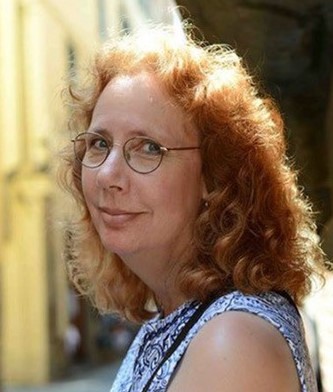
Image reproduced with permission of the artist.
Lee Brandt Randall is an artist, book illustrator, and art educator in Baton Rouge. She worked as a classroom teacher for over 30 years, much of that time as the head of the Runnels School Art Department. Talented in a wide variety of media, she holds a degree in printmaking from Louisiana State University and has illustrated several books. In her spare time, she is the costume designer for the legendary Krewe of Yazoo Precision Lawnmower Drill Team whose members refer to her as the “MacGyver of Rubber Foam.

